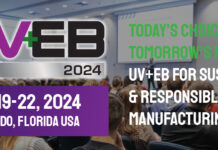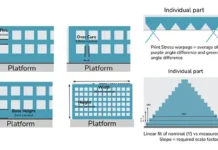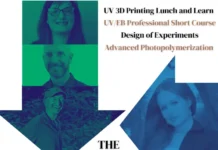By Dianna Brodine, managing editor, UV+EB Technology
RadTech, the nonprofit association for UV/EB photopolymer chemistry, in cooperation with The National Institute of Standards and Technology (NIST), has formed the Photopolymer Additive Manufacturing Alliance (PAMA), to engage industry, academia, government and nongovernmental organizations to advance materials and systems science for additive manufacturing. PAMA is an outgrowth of the Photopolymer Additive Manufacturing Workshop: Roadmapping a Future for Stereolithography, Inkjet and Beyond – the October 2019 event, held in Boulder, Colorado. The workshop brought together 80 participants from all sectors – people and companies that were invested in additive manufacturing.

According to summary information provided after the event: “This workshop was the first of its kind for photopolymer additive manufacturing. It drew on the experience and future plans of end-users, OEMs, resin suppliers and researchers, to provide critical insights and perspectives on current capabilities, challenges, priority R&D needs and future opportunities, especially as additive manufacturing innovation accelerates. The meeting agenda targeted the definition of state-of-the-art characterization techniques for resins and printers, determining where additive manufacturing technology is heading and identifying measurement and standards barriers (opportunities) to achieving technology goals.”
Photopolymer additive manufacturing has the highest level of build resolution among additive manufacturing technologies, resulting in higher resolution and smooth surfaces that do not require additional finishing. “Photopolymer additive manufacturing also is stronger in the Z axis due to chemical bonding between the layers, which makes the part stronger,” explained Mike Idacavage, RadCure LLC. “We can generate pieces that will act like a solid block of plastics. There are 40 or 50 types of additive manufacturing, but UV curing sits at the top of the pyramid in terms of strength and performance.
After the workshop, a report was issued that outlined key barriers, recommended research directions and roadmapped solutions (https://nvlpubs.nist.gov/nistpubs/SpecialPublications/NIST.SP.1500-17.pdf). PAMA is a direct result of those findings. “Attendees found five areas that we felt would really encapsulated the needs for the photopolymer additive manufacturing industry,” said Idacavage. These included Material Science and Engineering to Characterize PAM Materials; Advanced Computing for Materials Discovery and Process Modeling; Measurement Science and Standards Development for Reliable, High-Performance PAM; Environmental, Health and Safety Regulations for Safe and Responsible PAM Adoption; and Industry Collaborations to Enhance PAM Utility.
“These areas were selected by attendees as the directions in which to focus, but the next step is taking the directions that were developed in 2019 and finding a successful path forward,” said Idacavage. “PAMA is the result.”
To introduce the new group, PAMA convened a two-part virtual workshop in November to provide an overview and opportunities for photopolymer materials and systems characterization within additive manufacturing. The workshop featured an overview of PAMA, interactive networking sessions with focused topics and an open discussion regarding state-of-the-art tools and methods to characterize PAM materials (see Image 1). Invited panelists included Jeff Stansbury, University of Colorado Anschutz Campus; Stephanie Benight, Tactile Material Solutions; Neil Cramer, Arkema; H. Jerry Qi, Georgia Institute of Technology; Robert McLeod, University of Colorado Boulder; David Walker, Azul3D; Cameron Miller, NIST; Xiayun Zhao, University of Pittsburgh; and Dianne Poster, NIST.
“The Photopolymer Additive Manufacturing Roadmap highlights key actions that must be taken for photopolymer additive manufacturing to be a substantial contributor to global manufacturing,” said Idacavage. “The Photopolymer Additive Manufacturing Alliance Webinars in November is significant step to accelerate photopolymer additive manufacturing collaboration and research.”
For details, visit https://radtech.org/pama/pama-webinars/.





